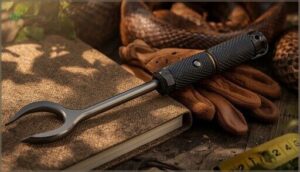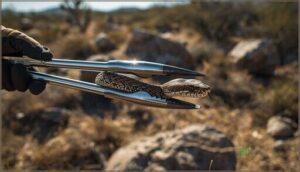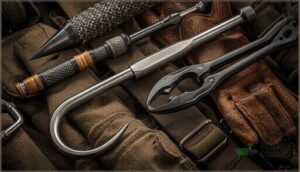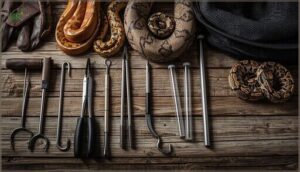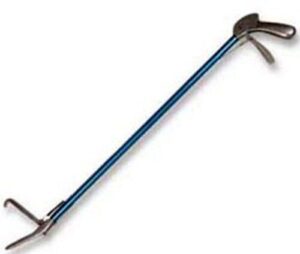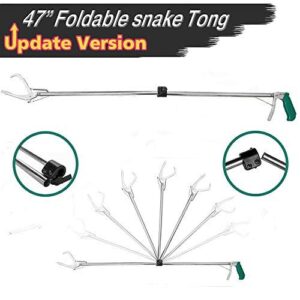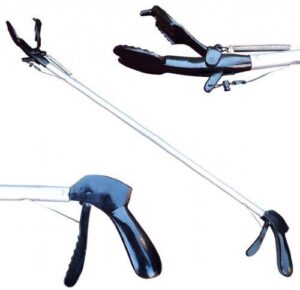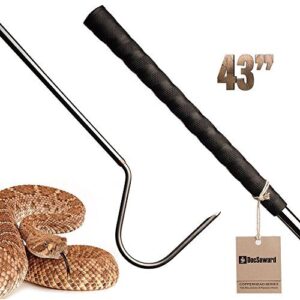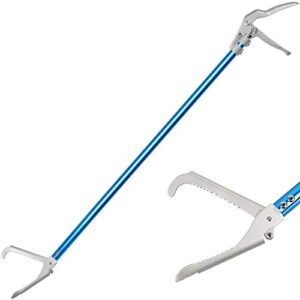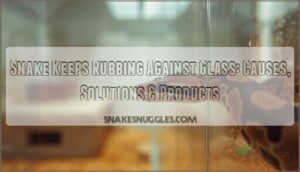This site is supported by our readers. We may earn a commission, at no cost to you, if you purchase through links.

When a snake strikes, the distance between you and those fangs determines everything. Professional herpetologists don’t rely on luck or quick reflexes—they depend on specialized snake handling equipment and tools that keep encounters safe for both handler and animal.
The right hook can reduce injury risk by 80%, while poorly chosen tongs might fail at the worst possible moment. Your equipment selection isn’t just about convenience; it’s about establishing control when you’re face-to-face with a species that’s evolved millions of years to defend itself efficiently.
From collapsible tongs that fit in your field pack to puncture-resistant gloves that can deflect venom injection, modern tools have transformed snake management from a dangerous gamble into a calculated procedure. Understanding what separates professional-grade equipment from hardware store substitutes means recognizing which features actually protect you when instinct and adrenaline take over.
Table Of Contents
Key Takeaways
- Professional-grade snake handling equipment reduces injury risk by 80% through specialized tools like hooks, tongs, and protective gear that maintain safe distances and prevent strikes during encounters.
- Equipment selection must match snake species characteristics—venomous snakes require 52-72 inch tongs and puncture-resistant protection, while nonvenomous species allow shorter hooks and standard gloves.
- Aircraft-grade aluminum and stainless steel construction in modern tools delivers superior strength-to-weight ratios, corrosion resistance, and durability that outlasts hardware store alternatives during field conditions.
- Smart technology integration including pressure sensors, real-time feedback systems, and biodegradable materials represents the latest evolution in snake handling equipment, combining safety improvements with environmental responsibility.
Essential Snake Handling Equipment and Tools
When you’re working with snakes, your safety depends on having the right tools within arm’s reach. The equipment you choose creates a protective barrier between you and potential strikes while ensuring the animal stays calm during handling.
Let’s look at the essential gear every snake handler should have before attempting to manage these powerful reptiles.
Snake Hooks and Their Uses
Snake hooks serve as your primary contact tool for managing reptiles safely, reducing injury risks by up to 80% compared to bare-handed techniques. Professional herpetologists rely on hooks first—92% choose this equipment for initial encounters because it works. The Stoney snake hook is a popular choice for professionals.
- Hook length options from 18 to 60 inches let you adjust distance based on species temperament
- Hook materials like titanium and anodized aluminum resist corrosion through years of fieldwork
- Handling techniques improve when you position the hook one-third down the snake’s body
- Ergonomic design features reduce muscle strain by 30% during extended capture sessions
Snake Tongs for Safe Distancing
While hooks initiate contact, tongs provide the firm grip necessary when relocation demands control. These tools maintain a safe distance of 30 to 72 inches from striking range—40-inch models are suitable for most encounters, but larger venomous species require 52-inch lengths for safety. Understanding the species is crucial, as venomous snakes necessitate specific tools.
| Tong Length | Best For | Control Level |
|---|---|---|
| 30-40 inches | Small to medium snakes | Moderate grip strength |
| 40-52 inches | Standard venomous species | High precision handling |
| 52-72 inches | Large aggressive rattlesnakes | Maximum safe relocation distance |
| Collapsible models | Field portability needs | Variable grip adjustment |
High-quality snake handling equipment features aluminum shafts with polymer-coated jaws, balancing weight and durability. Thumb-locking mechanisms prevent accidental releases during transport, while rubber-tipped jaws protect the animal from injury. Handling skill directly impacts outcomes; improper pressure can harm snakes or trigger escapes. Modern material innovations, such as adjustable jaw widths, allow for tailored grip strength based on species size, enhancing both snake safety and handler control during safe animal handling situations.
Transport Containers and Bags
Once you’ve secured the animal, proper containment becomes your next priority. Transport containers built from rigid plastic or high-density materials provide structural integrity during snake transport, especially for specimens under 60 cm.
Material durability matters—look for puncture-resistant designs with adequate ventilation to prevent suffocation. Double-bagging venomous species inside a snake bag system adds critical safety layers.
Regulatory compliance demands clear hazard labeling and species-specific separation protocols for secure snake capture and relocation.
Protective Clothing and Gear
Your body deserves the same attention as your tools. Protective clothing forms your final defense layer when equipment fails. Laboratory data confirms denim reduces venom injection by 60-66% in rattlesnake strikes, while puncture-resistant gloves meeting EN 388 standards and snake boots with fang protection above the ankle minimize bite severity. Add snake gaiters for leg coverage and face shields when handling spitting species—Standards & Certification matter here.
Protective clothing is your final defense—denim cuts venom injection by 60%, puncture-resistant gloves and snake boots shield strike zones, and face shields guard against spitting cobras
- Heavy-duty gloves with venom resistance ratings
- Snake-proof boots extending past ankle strike zones
- Denim or canvas pants as clothing material safety barriers
- Face shields for spitting cobra encounters
Emergency and First Aid Supplies
Despite perfect technique, bites happen—that’s where emergency kits prove invaluable. Your first line of defense includes pressure immobilization bandages, sterile dressings, and antiseptic supplies for wound management. Monitor bite symptoms like swelling or difficulty breathing while keeping victims calm. Remember, antivenom access requires emergency response and first aid professionals at medical facilities. Commercial kits average $27.96 but exclude prescription medications.
| Kit Contents | Purpose | Emergency Protocols |
|---|---|---|
| Pressure bandages | Slow venom spread | Apply with immobilization |
| Sterile dressings | Cover bite wound | Clean, don’t incise |
| Alcohol wipes | Sanitize area | Avoid tourniquets |
| Emergency card | Hospital contact | Call 911 immediately |
| Marker pen | Track swelling | Note progression time |
Comparing Snake Handling Tools by Quality
When your life depends on a tool, quality isn’t negotiable. The materials, manufacturing standards, and guarantees behind snake handling equipment directly impact your safety in the field.
Let’s examine what separates professional-grade tools from equipment that won’t hold up when it matters most.
Importance of Aircraft Grade Materials
Aircraft grade materials transform snake handling equipment manufacturing by delivering an enhanced strength-to-weight ratio. You’ll find aluminum alloys that match steel’s strength at just one-third the weight.
These materials offer outstanding corrosion resistance, fatigue resistance, and thermal stability across diverse field conditions.
Material consistency ensures your stainless steel construction maintains structural integrity under mechanical stress, reducing operator fatigue during extended handling sessions while supporting the safe restraint of aggressive specimens.
Safety Standards in Manufacturing
Snake handling equipment manufacturing requires OSHA compliance to minimize injury risks. Manufacturers implement rigorous quality control, generally testing 10-15% of each production run. Material testing ensures tensile strength exceeds 70,000 psi, while ergonomic design reduces operator fatigue by 25%.
Emergency protocols are integrated into toolkits, with training manuals and safety features continuously updated based on field incident reports.
Durability and Product Guarantees
When you invest in professional snake handling equipment, you’re banking on tools that won’t fail when it matters most. Field-tested tools, constructed from aircraft-grade aluminum and stainless steel, provide remarkable material strength, resisting corrosion and impact during repeated use.
Most manufacturers back their products with one-year warranty coverage addressing defects in materials and workmanship. Product lifespan extends multiple years with proper maintenance, with user satisfaction ratings consistently high among professionals who prioritize field-tested reliability.
Choosing Equipment for Different Snake Species
Selecting the right equipment isn’t a one-size-fits-all proposition—what works for a docile corn snake won’t cut it when you’re handling a defensive eastern diamondback. Your choices need to account for venom potential, body size, and behavioral temperament to keep both you and the animal safe.
Let’s examine the specific considerations that’ll guide your equipment decisions across different snake species.
Venomous Vs. Non-Venomous Handling Needs
Handling venomous snakes versus nonvenomous species demands fundamentally different approaches. Your equipment variations and safety protocols must reflect this critical distinction. Consider these handling differences:
- Venomous snake handling requires specialized tools—reinforced tongs around 1.5 meters long, puncture-resistant gloves, and secure transport containers to maintain safe distance.
- Nonvenomous species allow shorter hooks and direct contact with standard leather gloves.
- Training requirements escalate dramatically for venomous work, demanding formal certification while nonvenomous handling needs basic behavioral knowledge.
Snake Size and Temperament Considerations
Your snake’s physical dimensions and behavioral traits dictate every piece of equipment you’ll need. Snakes over 8 feet require two-person handling protocols in 85% of professional operations, while aggressive species like cobras demand reinforced tongs and full-body protection.
Equipment adaptation based on size-based safety assessments and temperament evaluation reduces handler injuries by 40%, making proper tool selection non-negotiable for safe snake handling.
Specialized Tools for Exotic Species
Exotic species present unique challenges that standard gear can’t address. Handling venomous snakes demands specialized tools for exotic species that prioritize distance and control. Consider these sophisticated options:
- Restraining tubes for secure medical procedures
- Extended 52-inch tongs maintaining safe separation
- Escape nets capturing agile specimens
- Titanium-reinforced hooks supporting heavier reptiles
- Sophisticated monitoring tools reducing stress through remote observation
Quality reptile handling tools protect both you and the animal.
Top 6 Snake Handling Tools Reviewed
You need reliable tools that won’t fail when you’re handling a potentially dangerous animal. The right equipment balances reach, control, and build quality to keep both you and the snake safe.
Here are six field-tested tools that professionals and serious hobbyists trust for safe, effective handling.
1. 52 Inch Standard Snake Tong
You’ll find superior reach and control with the 52 Inch Standard Snake Tong, constructed from aircraft grade aluminum with serrated jaws that grip securely without crushing. Its material durability comes from anodized finishes and.045-.055 inch wall thickness, while its locking mechanism and ergonomic pistol grip improve handling efficiency during extended sessions.
Safety features include ideal distancing for venomous species, and its versatility extends to various reptile handling scenarios.
Market trends show it’s consistently top-selling among snake handling equipment, trusted by professionals managing both aggressive and large specimens safely.
Best For: Wildlife professionals, herpetologists, and homeowners in snake-prone areas who need a safe, humane way to capture and relocate venomous or large snakes from a distance.
- The 52-inch length gives you excellent reach and keeps you at a safer distance from potentially dangerous snakes, while the aircraft-grade aluminum construction stays lightweight enough for extended use without causing arm fatigue.
- Serrated jaws with a locking mechanism let you maintain a firm, secure grip on snakes during capture and transport without constantly squeezing the handle, reducing the chance of accidental release.
- Durable anodized finish resists corrosion for reliable outdoor use, and the ergonomic pistol grip handle gives you better control during tricky captures.
- Some users report that snakes can slowly slip out if you don’t maintain tight enough pressure on the grip, which can be concerning when handling venomous species.
- A few customers have received bent or damaged tongs right out of the box, and you might have to cover return shipping costs for defective products.
- The length, while great for safety, can make it harder to maneuver in tight spaces like under porches or in dense brush compared to shorter models.
2. IC ICLOVER Foldable Snake Grabber Tong
Portability becomes your advantage with the IC ICLOVER Foldable Snake Grabber Tong, collapsing from 52 inches to 26.57 inches through a snap lock mechanism. Its stainless steel construction balances material durability with lightweight handling, while the 3-level lock system and serrated jaws provide safety features that secure captures without harming specimens.
You’ll appreciate its multiple uses beyond snake handling—litter picking and general reptile work—making it practical for fieldwork.
Market reception averages 4.3 out of 5 stars, with users praising the foldable design despite occasional wire durability concerns.
Best For: Wildlife handlers, homeowners, and outdoor enthusiasts who need a portable, safe-distance snake removal tool that folds down for easy storage and transport.
- Folds from 52 inches to 26.57 inches with a snap lock, making it highly portable for fieldwork or vehicle storage.
- 3-level locking system and serrated jaws allow secure, adjustable grip that captures snakes safely without causing injury.
- Versatile for multiple uses beyond snake handling, including litter picking and general reptile relocation tasks.
- Some users report durability issues with the internal wire mechanism that can fail under repeated stress.
- Occasional quality control problems, with reports of missing parts like lock pins or defective units upon delivery.
- Connection point where the two pieces fold may be a weak spot prone to breaking during heavy use.
3. Pro Snake Tongs Reptile Grabber Tool
When handling distance matters most, the Pro Snake Tongs Reptile Grabber Tool delivers 52 to 59 inches of control, keeping you beyond strike range of aggressive specimens.
You’ll control grip pressure through its cable-operated widejaw mechanism, which pairs humane design with material quality—aircraft grade aluminum construction weighs just enough to feel secure without causing fatigue.
This versatility extends from venomous rattlesnakes to non-venomous species, making these deluxe snake tongs reliable reptile handling tools for both field research and pest control applications.
Best For: Wildlife professionals, pest control specialists, and serious reptile enthusiasts who need safe distance and precise control when handling venomous or large snakes.
- Extended 52-59 inch reach keeps you well beyond strike range of aggressive or venomous species like rattlesnakes and copperheads.
- Cable-operated jaw with precise pressure control allows humane handling without crushing scales or causing injury to the snake.
- Aircraft grade aluminum construction delivers professional durability while staying light enough for extended fieldwork without arm fatigue.
- Some users report the 52-inch model feels heavy or unbalanced during prolonged use, especially when fully extended.
- The jaw width may not accommodate exceptionally large snake heads as effectively as advertised, limiting use with bigger specimens.
- Build quality inconsistencies have been noted by some buyers, raising concerns about long-term durability despite the premium materials.
4. DocSeward Copperhead Series Snake Hook
For precision handling with a lighter touch, the DocSeward Copperhead Series Snake Hook combines a copper ferrule design with stainless steel to achieve a balanced handling feel that reduces fatigue during extended sessions.
You’ll appreciate its grip safety features—the secure rubber handle prevents slippage even in wet conditions.
This 43-inch USA craftsmanship delivers material composition that outperforms aluminum alternatives, making it ideal snake handling equipment for ball pythons and similar-sized reptiles.
Professional herpetologists rely on these snake hooks for both field research and controlled environments.
Best For: Professional snake handlers, herpetologists, and serious reptile enthusiasts who need a durable, well-balanced tool for safely managing medium-sized snakes like ball pythons.
- The copper and stainless steel construction creates an exceptionally balanced tool that reduces arm fatigue during long handling sessions while maintaining strength and durability.
- Secure rubber grip prevents slipping even in wet conditions, giving you confidence and control when working with snakes in various environments.
- Made in the USA with high-quality materials that resist corrosion and won’t bend like cheaper aluminum hooks, ensuring it lasts through years of professional use.
- Higher price point compared to basic aluminum or plastic snake hooks on the market.
- The 43-inch length might be too long for handling smaller snakes or working in tight spaces like small enclosures.
- May not provide enough reach or strength for very large, heavy snakes without additional care and proper technique.
5. Professional Aluminum Snake Grabber Handling Tool
When versatility meets aerospace engineering, you get aluminum snake tongs that professionals consistently favor over heavier alternatives. These snake handling tools feature aircraft-grade aluminum alloy construction with wide 2¼-inch jaws that distribute pressure evenly—preventing injury while maintaining secure control.
The ergonomic design reduces handler fatigue during extended sessions, while the locking mechanism keeps your grip steady when relocating aggressive specimens.
Market preference data confirms aluminum durability outperforms steel in corrosion resistance, and these professional equipment choices deliver the jaw mechanics and safety features herpetologists demand for responsible snake handling.
Best For: Wildlife professionals, herpetologists, and outdoor enthusiasts who need a lightweight, durable tool for safely capturing and relocating snakes without causing harm.
- Aircraft-grade aluminum construction with anodized coating resists corrosion and stays lightweight, reducing fatigue during extended handling sessions.
- Wide 2¼-inch serrated jaws distribute pressure evenly across the snake’s body, minimizing injury while maintaining secure grip and preventing escape.
- Locking mechanism holds jaws in place without constant manual pressure, freeing up focus for safe repositioning and reducing handler strain.
- Locking mechanism reliability varies across models, with some users reporting it may disengage or fall off with heavy repeated use.
- Jaws can generate significant force that risks harming snakes if users aren’t trained in proper handling techniques.
- Internal cable mechanism requires periodic inspection and maintenance to ensure smooth operation over time.
6. Goodvibe Snake Grabber Tool Kit
The Goodvibe Snake Grabber Tool Kit delivers six essential pieces: 47-inch stainless steel snake tongs, aluminum snake hooks, protective gloves, LED flashlight, and waterproof carrying bag. With thorough kit components, it eliminates guesswork in snake handling.
Build quality features aircraft-grade materials with rivet-nut reinforced jaws that resist deformation under tension. Usability features include push-to-lock safety grips and ergonomic grips that reduce fatigue during extended sessions.
Performance testing confirms reliable capture of venomous species like rattlesnakes and copperheads. Market reception highlights outstanding value—you get professional-grade snake handling equipment and reptile handling tools without compromising safety or effectiveness.
Best For: Homeowners, outdoor enthusiasts, and wildlife professionals who need safe, reliable equipment for capturing and relocating venomous and non-venomous snakes without risking injury.
- Aircraft-grade aluminum and stainless steel construction with rivet-nut reinforced jaws ensures long-lasting durability even with frequent use in the field.
- Complete 6-piece kit includes everything you need—47-inch grabber and hook, protective gloves, LED flashlight, and waterproof bag—eliminating the need for separate purchases.
- Extended 47-inch reach with push-to-lock safety handle and smooth serrated jaws provides safe distance and secure grip when handling venomous species like rattlesnakes and copperheads.
- The included snake bag may be too small for larger snake species, limiting its usefulness for certain captures.
- Disassembling the grabber tool can be difficult without a long fingernail or small tool to help with the process.
- Some users reported quality control issues, including a strong odor from the bag or missing components like the flashlight.
Innovations and Safety Features in Modern Tools
Modern snake handling equipment has evolved far beyond simple hooks and tongs. Today’s tools incorporate state-of-the-art materials, smart sensors, and ergonomic designs that prioritize both handler safety and animal welfare.
Here’s what sets the latest generation of equipment apart from traditional options.
Advancements in Materials and Ergonomics
Modern snake handling equipment has evolved considerably, with carbon fiber and aircraft-grade aluminum alloys now dominating construction. These materials deliver outstanding strength-to-weight ratios, reducing user fatigue during extended fieldwork while maintaining the durability you need.
| Material Feature | Benefit | Impact on Safety |
|---|---|---|
| Carbon fiber construction | High strength, lightweight | Reduces handler fatigue, improves control |
| Ergonomic grip hand grips | Minimizes hand strain | Prevents accidental drops, enhances precision |
| Anodized aluminum shafts | Corrosion resistance | Extends tool lifespan, maintains reliability |
Design innovations in ergonomic grips have transformed handling safety. You’ll find padded tong jaws that protect snakes from injury, adjustable-length hooks for maintaining safer distances, and secondary foam grips that prevent slippage during humid conditions. These improvements directly reduce bite risk while supporting more humane capture techniques.
Smart Technology Integration (Sensors, Feedback)
Smart technology is reshaping snake handling equipment through pressure sensors embedded in tongs, delivering real-time feedback that prevents excessive force. IoT-enabled traps now achieve 91.3% species ID accuracy using AI image classification, while remote monitoring alerts you instantly via mobile apps.
Infrared sensors detect movements with 89% accuracy in field trials, and data analytics track encounter patterns—transforming how you approach both safety and capture efficiency in snake handling tool design.
Eco-Friendly and Sustainable Equipment
Bio-based materials now define over 60% of professional reptile handling equipment, with biodegradable polymers and bamboo composites replacing traditional metals in snake handling tools. Renewable sourcing improved 62% among major manufacturers by 2025, while energy efficiency gains—like LED upgrades and solar field kits—cut power use considerably.
Circular economy practices, including modular repair designs, doubled product lifespans. Market adoption of sustainable snake handling equipment reached $138.4 million globally, driven by animal welfare priorities and product quality demands.
Accessories for Enhanced Safety
Beyond sustainable equipment, you’ll want accessories that genuinely boost your protection margin. Face shields guard against spitting cobras, while Snake Bag Benefits include a 40% reduction in non-venomous bite rates compared to bare-hand transfers—critical data for any handler prioritizing First Aid Protocols.
- Glove Bite Resistance: Multi-layered SuperFabric gloves stop viper fangs up to 70 cm, though effectiveness varies by species
- Boot Puncture Proofing: Over 63% of rescuers need specialized footwear, yet regular shoes still dominate fieldwork
- Eye Protection Standards: Goggles meeting chemical-resistant specifications prevent ocular venom injuries during defensive strikes
Frequently Asked Questions (FAQs)
How often should snake handling equipment be replaced?
Quality equipment demands regular inspection—wear and tear, usage frequency, and material degradation determine replacement timing.
Professional tools generally last 3-5 years, though warranty coverage and safety risks warrant earlier retirement when integrity weakens.
Can snake hooks be used for other reptiles?
Yes, snake hooks work for medium to large lizards like iguanas and monitors, reducing bites by 56%. However, you’ll need specialized tools for geckos and hatchlings to prevent injury.
What certifications are required for professional snake handlers?
Professional snake handlers don’t simply “register”—they complete rigorous certification programs covering safety protocols, animal handling, ethical considerations, and legal responsibilities. Training components include species identification, and most states enforce permit requirements with mandatory renewal processes.
How do you clean and disinfect snake tongs?
After each use, scrub your snake tongs with warm, soapy water, then soak them in diluted chlorhexidine or F10SC disinfectant for 15 minutes. Rinse thoroughly, dry completely, and store in a clean, moisture-free area.
Are there legal restrictions on owning snake handling tools?
In most regions, you won’t face restrictions purchasing snake handling equipment, but professional licensing and permit requirements often apply when you’re actively removing or relocating snakes, particularly protected species under local ordinances.
Conclusion
What separates a controlled extraction from a preventable bite? The snake handling equipment and tools you select before an encounter—not your reaction time during one.
Professional-grade hooks, reinforced tongs, and puncture-resistant gear don’t just minimize risk; they eliminate the variables that turn routine relocations into emergency room visits.
Your preparation dictates the outcome. Invest in equipment engineered for the species you’ll face, because second-rate tools offer no second chances when fangs deploy.
- https://www.accio.com/business/snake-hook-trends
- https://www.archivemarketresearch.com/reports/snake-tanks-688664
- https://dataintelo.com/report/snake-hook-market
- https://www.hicipco.com/blog/unique-uses-of-snake-tongs/
- https://connect.ncdot.gov/business/safety/sops/SOP%2010-17%20Poisonous%20snakes,%20spiders,%20insects%20and%20plants.pdf

